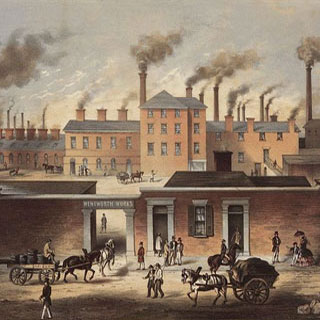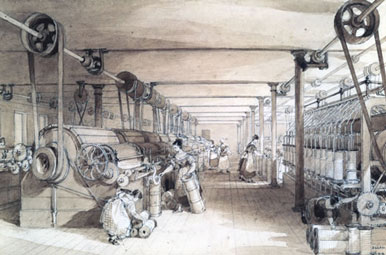The Industrial Revolution
Industrial Revolution

The Industrial Revolution was the major technological, socioeconomic and cultural change in the late 18th and early 19th century Britain in the United Kingdom. During that time, an economy based on manual labour was replaced by machinery.
It began with the mechanisation of the textile industries and the development of iron-making techniques, and trade expansion was enabled by the introduction of canals, improved roads and then railways. The introduction of steam power (fueled primarily by coal) and powered machinery (mainly in textile manufacturing) underpinned the dramatic increases in production capacity. The development of all-metal machine tools in the first two decades of the 19th century facilitated the manufacture of more production machines for manufacturing in other industries.
The effects

The Industrial Revolution was absolutely beneficial to the progress of the world from the 1800s all the way to present day. Sacrifices were made which allowed technological advancements during the Industrial Revolution, which in turn, created happiness, life opportunities, and an over-all, definite improvement of life.
There were many national benefits of this revolution. One very important thing was that there became many more goods available because of the mass-production. Due to this mass-producing, the goods also dropped in price, which considerably benefited those who were financially struggling. Along with the mass-producing came more employment opportunities, which allowed some of the less fortunate people to have a chance of getting a job. The increase of new ideas and inventions led to an increase of the quality of life. Medicinal products became more plentiful, transportation improved, and free education was available. People began to find themselves with more leisure time. Wages were increased, health benefits became available, and eventually, pension became available to those who retired. These are just some of the many aspects of the revolution that benefited the people as a nation, which made them happier, and made the government safer from rebellion.
These effects spread throughout Western Europe and North America, eventually affecting the majority of the world. The impact of this change on society was enormous and is often compared to the Neolithic revolution, when mankind developed agriculture and gave up its nomadic lifestyle.
The first Industrial Revolution merged into the Second Industrial Revolution around 1850, when technological and economic progress gained momentum with the development of steam-powered ships and railways, and later in the nineteenth century with the internal combustion engine and electrical power generation.